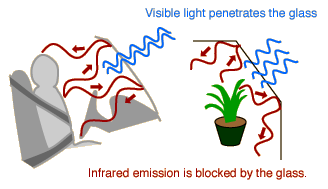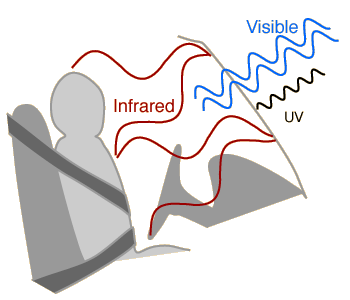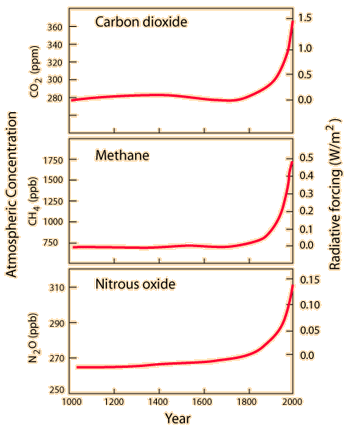"What is global warming?"
Global warming is when the earth heats up (the temperature rises). It happens when greenhouse gases (carbon dioxide, water vapor, nitrous oxide, and methane) trap heat and light from the sun in the earth’s atmosphere, which increases the temperature. This hurts many people, animals, and plants. Many cannot take the change, so they die.
What is the greenhouse effect?
The greenhouse effect is when the temperature rises because the sun’s heat and light is trapped in the earth’s atmosphere. This is like when heat is trapped in a car. On a very hot day, the car gets hotter when it is out in the parking lot. This is because the heat and light from the sun can get into the car, by going through the windows, but it can’t get back out. This is what the greenhouse effect does to the earth. The heat and light can get through the atmosphere, but it can’t get out. As a result, the temperature rises.
 |
| The squiggle lines coming from the sun are visible light and the lines and arrows inside the car are infrared light. |
The sun’s heat can get into the car through the windows but is then trapped. This makes what ever the place might be, a greenhouse, a car, a building, or the earth’s atmosphere, hotter. This diagram shows the heat coming into a car as visible light (light you can see) and infrared light (heat). Once the light is inside the car, it is trapped and the heat builds up, just like it does in the earth’s atmosphere.
Sometimes the temperature can change in a way that helps us. The greenhouse effect makes the earth appropriate for people to live on. Without it, the earth would be freezing, or on the other hand it would be burning hot. It would be freezing at night because the sun would be down. We would not get the sun’s heat and light to make the night somewhat warm. During the day, especially during the summer, it would be burning because the sun would be up with no atmosphere to filter it, so people, plants, and animals would be exposed to all the light and heat.
Although the greenhouse effect makes the earth able to have people living on it, if there gets to be too many gases, the earth can get unusually warmer, and many plants, animals, and people will die. They would die because there would be less food (plants like corn, wheat, and other vegetables and fruits). This would happen because the plants would not be able to take the heat. This would cause us to have less food to eat, but it would also limit the food that animals have. With less food, like grass, for the animals that we need to survive (like cows) we would even have less food. Gradually, people, plants, and animals would all die of hunger.
What are greenhouse gasses?
Greenhouse gasses are gasses are in the earth’s atmosphere that collect heat and light from the sun. With too many greenhouse gasses in the air, the earth’s atmosphere will trap too much heat and the earth will get too hot. As a result people, animals, and plants would die because the heat would be too strong.
What is global warming doing to the environment?
Global warming is affecting many parts of the world. Global warming makes the sea rise, and when the sea rises, the water covers many low land islands. This is a big problem for many of the plants, animals, and people on islands. The water covers the plants and causes some of them to die. When they die, the animals lose a source of food, along with their habitat. Although animals have a better ability to adapt to what happens than plants do, they may die also. When the plants and animals die, people lose two sources of food, plant food and animal food. They may also lose their homes. As a result, they would also have to leave the area or die. This would be called a break in the food chain, or a chain reaction, one thing happening that leads to another and so on.
animals, and people on islands. The water covers the plants and causes some of them to die. When they die, the animals lose a source of food, along with their habitat. Although animals have a better ability to adapt to what happens than plants do, they may die also. When the plants and animals die, people lose two sources of food, plant food and animal food. They may also lose their homes. As a result, they would also have to leave the area or die. This would be called a break in the food chain, or a chain reaction, one thing happening that leads to another and so on.
The oceans are affected by global warming in other ways, as well. Many things that are happening to the ocean are linked to global warming. One thing that is happening is warm water, caused from global warming, is harming and killing algae in the ocean.
 Algae is a producer that you can see floating on the top of the water. (A producer is something that makes food for other animals through photosynthesis, like grass.) This floating green algae is food to many consumers in the ocean. (A consumer is something that eats the producers.) One kind of a consumer is small fish. There are many others like crabs, some whales, and many other animals. Fewer algae is a problem because there is less food for us and many animals in the sea.
Algae is a producer that you can see floating on the top of the water. (A producer is something that makes food for other animals through photosynthesis, like grass.) This floating green algae is food to many consumers in the ocean. (A consumer is something that eats the producers.) One kind of a consumer is small fish. There are many others like crabs, some whales, and many other animals. Fewer algae is a problem because there is less food for us and many animals in the sea.
Global warming is doing many things to people as well as animals and plants. It is killing algae, but it is also destroying many huge forests. The pollution that causes global warming is linked to acid rain. Acid rain gradually destroys almost everything it touches. Global warming is also causing many more fires that wipe out whole forests. This happens because global warming can make the earth very hot. In forests, some plants and trees leaves can be so dry that they catch on fire.
What causes global warming?
Many things cause global warming. One thing that causes global warming is electrical pollution. Electricity causes pollution in many ways, some worse than others. In most cases, fossil fuels are burned to create electricity. Fossil fuels are made of dead plants and animals. Some examples of fossil fuels are oil and petroleum. Many pollutants (chemicals that pollute the air, water, and land) are sent into the air when fossil fuels are burned. Some of these chemicals are called greenhouse gasses.
We use these sources of energy much more than the sources that give off less pollution. Petroleum, one of the sources of energy, is used a lot. It is used for transportation, making electricity, and making many other things. Although this source of energy gives off a lot of pollution, it is used for 38% of the United States’ energy.
Some other examples of using energy and polluting the air are:
Turning on a light | |
Watching T.V. | |
Listening to a stereo | |
Washing or drying clothes | |
| Using a hair dryer | |
Riding in a car | |
Heating a meal in the microwave | |
| Using an air conditioner | |
Playing a video game | |
Using a dish washer |
When you do these things, you are causing more greenhouse gasses to be sent into the air. Greenhouse gasses are sent into the air because creating the electricity you use to do these things causes pollution. If you think of how many times a day you do these things, it’s a lot. You even have to add in how many other people do these things! That turns out to be a lot of pollutants going into the air a day because of people like us using electricity. The least amount of electricity you use, the better.
 When we throw our garbage away, the garbage goes to landfills. Landfills are those big hills that you go by on an expressway that stink. They are full of garbage. The garbage is then sometimes burned. This sends an enormous amount of greenhouse gasses into the air and makes global warming worse.
When we throw our garbage away, the garbage goes to landfills. Landfills are those big hills that you go by on an expressway that stink. They are full of garbage. The garbage is then sometimes burned. This sends an enormous amount of greenhouse gasses into the air and makes global warming worse.
Another thing that makes global warming worse is when people cut down trees. Trees and other plants collect carbon dioxide (CO2), which is a greenhouse gas.
Carbon dioxide is the air that our body lets out when we breathe. With fewer trees, it is harder for people to breathe because there is more CO2 in the air, and we don’t breathe CO2, we breathe oxygen. Plants collect the CO2 that we breathe out, and they give back oxygen that we breathe in. With less trees and other plants, such as algae, there is less air for us, and more greenhouse gases are sent into the air. This means that it is very important to protect our trees to stop the greenhouse effect, and also so we can breathe and live.
This gas, CO2, collects light and heat (radiant energy), produced by the sun, and this makes the earth warmer. The heat and light from the sun is produced in the center of the sun. (The sun has layers just like the earth.)
 |
| The dirty yellow color on outside is the surface. The light and dark yellow colored area is the convection zone. The orange colored area is the radiative zone, and the red colored area is the core. The squiggle lines represent radiant energy. |
This layer is called the core. Just like a core of an apple, it is in the middle. Here there is a very high temperature, about 27,000,000°F. This heat escapes out of this layer to the next layer, the radiative zone. This layer is cooler, about 4,500,000°F. Gradually, the heat and light will pass through the convection zone at a temperature of around 2,000,000°F. When it gets to the surface, the temperature is about 10,000°F. Finally, the heat and light is sent into space. This is called radiant energy (heat and light). The radiant energy reaches the earth’s atmosphere. As a result of this process we get light and heat. When you pollute, you send chemicals into the air that destroy our atmosphere, so more heat and light cannot escape from the earth’s atmosphere.
What are people doing to stop global warming?
People are doing many things to try to stop global warming. One thing people are doing is carpooling. Carpooling is driving with someone to a place that you are both going to. This minimizes the amount of greenhouse gases put into the air by a car.
Another thing that people are doing is being more careful about leaving things turned on like the television, computer, and the lights. A lot of people are taking time away from the television, and instead, they are spending more time outdoors. This helps our planet out a lot. Now, more people are even riding busses, walking to school, and riding their bikes to lower the amount of greenhouse gases in the air. Planting trees and recycling also helps. If you recycle, less trash goes to the dump, and less trash gets burned. As a result, there are fewer greenhouse gasses in our atmosphere.
Watch what you buy. Many things, such as hairspray and deodorant, now are made to have less of an impact on the atmosphere. Less greenhouse gasses will rise into the air, and global warming will slow down.
What is the government doing to stop global warming?
The government is doing many things to help stop global warming. The government made a law called The Clean Air Act so there is less air pollution. Global warming is making people get very bad illnesses that could make them disabled, very sick, and sometimes even die. The Clean Air Act is making many companies change their products to decrease these problems. Part of the law says that you may not put a certain amount of pollutants in the air. Hairspray and some other products, like foam cups, had this problem. Making and using these products let out too much volatile organic compounds (VOC’s), ozone-destroying chemicals (chlorofluorocarbons (CFC’s), and related chemicals (such as CO2) into the air. Now, almost all of these products have a label on them telling people what this product can do to the environment and many people. By 2015 all products listed on the Clean Air Act will have this label on them:
| WARNING: contains or manufactured with (the chemical would go here. For example chlorofluorocarbons (CFC’s), a substance which harms public health and the environment by destroying ozone in the upper atmosphere. |
Almost all of the other chemicals that could be harmful will have this label on them hopefully by this time (2015) as well.
The Clean Air Act has also made car companies change some of the things inside of the cars. Cars pollute a lot. While cars make more than half of the world’s smog (visible pollution in the air), many things that cars need to move and heat up make even more pollution. Some things that are inside of cars, buses, trucks, and motorcycles, like gasoline, pollute the air when the fuel is burned. It comes out as a chemical and when mixed in the air, forms smog. Smog is a kind of pollution that you see in the form of a cloud. If you have ever been to California you can see a lot of smog in some places. Sometimes the smog gets so bad that you cannot see at all! Smog forms when car exhaust, pollution from homes, and pollution from factories mixes in the air and has a chemical reaction. The sun’s heat and light add to the reaction.
Cars, buses, and trucks are also responsible for over 50% of dangerous chemicals let into the air. Some of these chemicals can cause cancer, birth defects, trouble breathing, brain and nerve damage, lung injures, and burning eyes. Some of the pollutants are so harmful that they can even cause death.
What are some of the other dangerous chemicals?
Some other chemicals that cause air pollution and are bad for the environment and people are:
| Ozone- Ozone is produced when other pollution chemicals combine. It is the basic element of smog. It causes many different kinds of health issues dealing with the lungs. It can damage plants and limit sight. It can also cause a lot of property damage. | ||
| VOC’s (volatile organic compounds, smog formers)- VOC’s are let into the air when fuel is burned. This chemical can cause cancer. It can also harm plants. | ||
| NOx (nitrogen dioxide)- This chemical forms smog. It is also formed by burning sources of energy, like gas, coal, and oil, and by cars. This chemical causes problems in the respiratory system (including the lungs). It causes acid rain, and it can damage trees. This chemical can eat away buildings and statues. | ||
| CO (carbon monoxide)- The source of this chemical is burning sources of energy. It causes blood vessel problems and respiratory failures. | ||
| PM-10 (particulate matter)- The source of this chemical is plowing and burning down fields. It can cause death and lung damage. It can make it hard for people to breathe. The smoke, soot, ash, and dust formed by this chemical can make many cities dirty. | ||
| Sulfur Dioxide- This chemical is produced by making paper and metals. This chemical can cause permanent lung damage. It can cause acid rain which kills trees and damages building and statues. | ||
| Lead- This chemical is in paint, leaded gasoline, smelters, and in lead storage batteries. It can cause many brain and nerve damages and digestive problems.
|
Kid can help stop global warming, too!!
Although adults do many things to help stop global warming, kids can do just as much. Kids can’t do hard things like making a law, but we can do easier things like not watching as much TV. You can listen to your parents when they say, turn off your lights or go play outside. Listening to them and actually trying to help can help you, your environment, and the world.
Greenhouse EffectThe greenhouse effect refers to circumstances where the short wavelengths ofvisible light from the sun pass through a transparent medium and are absorbed, but the longer wavelengths of the infrared re-radiation from the heated objects are unable to pass through that medium. The trapping of the long wavelength radiation leads to more heating and a higher resultant temperature. Besides the heating of an automobile by sunlight through the windshield and the namesake example of heating the greenhouse by sunlight passing through sealed, transparent windows, the greenhouse effect has been widely used to describe the trapping of excess heat by the rising concentration of carbon dioxide in the atmosphere. The carbon dioxide strongly absorbs infrared and does not allow as much of it to escape into space.
A major part of the efficiency of the heating of an actual greenhouse is the trapping of the air so that the energy is not lost by convection. Keeping the hot air from escaping out the top is part of the practical "greenhouse effect", but it is common usage to refer to the infrared trapping as the "greenhouse effect" in atmospheric applications where the air trapping is not applicable. | Index | ||||||
| Go Back |
Greenhouse Effect ExampleBright sunlight will effectively warm your car on a cold, clear day by thegreenhouse effect. The longer infrared wavelengths radiated by sun-warmed objects do not pass readily through the glass. The entrapment of this energy warms the interior of the vehicle. The trapping of the hot air so that it cannot rise and lose the energy by convection also plays a major role.
Shorter wavelengths of ultraviolet light are largely blocked by glass since they have greater quantum energies which have absorption mechanisms in the glass. Even though you may be uncomfortably warm with bright sunlight streaming through, you will not be sunburned. | Index Blackbody radiation concepts | ||
| Go Back |
Increase in Greenhouse GasesThe increase in the concentration of carbon dioxide, one of the three majoratmospheric contributers to the greenhouse effect has been carefully documented at the Mauna Loa Observatory in Hawaii. The 1990 rate of increase was about 0.4% per year. The interesting cyclic variations represent the reduction in carbon dioxide by photosynthesis during the growing season in the northern hemisphere. Current analysis suggests that the combustion of fossil fuels is a major contributer to the increase in the carbon dioxide concentration, such contributions being 2 to 5 times the effect of deforestation (Kraushaar & Ristinen). Increase in Atmospheric Carbon Dioxide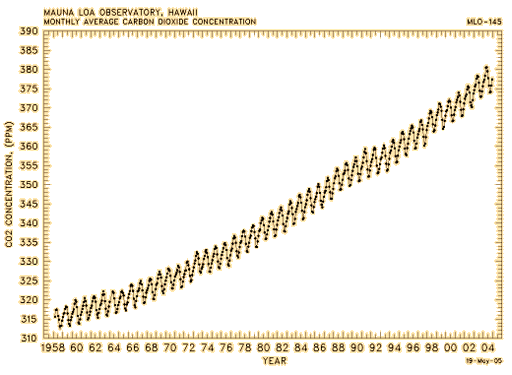 The Mauna Loa monitoring station reports the carbon dioxide level in the atmosphere today as about 380 parts per million compared to 315 ppm in 1958 when modern measurements were initiated. Measurements of air bubbles trapped in the Greenland ice sheet indicate concentrations of 270 ppm in preindustrial times.
| Index References Kraushaar & Ristinen Trefil | ||
| Go Back |
Contributers to Greenhouse EffectThose gas molecules in the Earth's atmosphere with three or more atoms are called "greenhouse gases" because they can capture outgoing infrared energy from the Earth, thereby warming the planet. The greenhouse gases include water vapor with three atoms (H2O), ozone (O3), carbon dioxide (CO2), and methane (CH4). Also, trace quantities of chloro-fluoro-carbons (CFC's) can have a disproportionately large effect.  To attempt to quantify the effects of greenhouse gases on the global temperature, climatologists use the "radiative forcing" of the current atmospheric content of these gases.
| Index Reference Kraushaar & Ristinen | ||
| Go Back |
Global WarmingAn issue of major concern is the possible effect of the burning of fossil fuels and other contributers to the increase of carbon dioxide in the atmosphere. The action of carbon dioxide and other greenhouse gases in trapping infrared radiation is called thegreenhouse effect. It may measurably increase the overall average temperature of the Earth, which could have disastrous consequences. Sometimes the effects of the greenhouse effect are stated in terms of the albedo of the Earth, the overall average reflection coefficient. 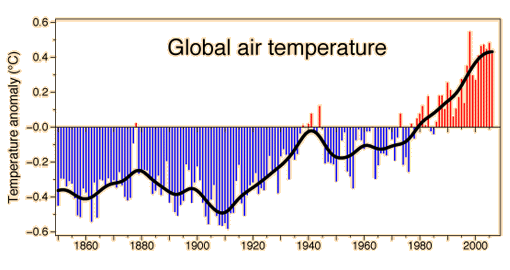 This graphic of the global air temperature was posted by Phil Jones on behalf of theClimatic Research Unit, UK. The key reference used was Brohan, et al. Another depiction of the mean temperatures in the northern hemisphere was drawn from NOAA. 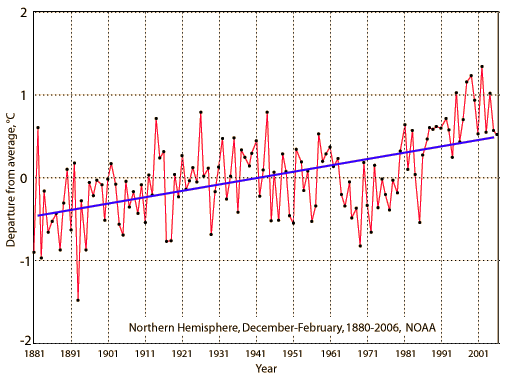 Essentially any kind of tabulation you access will tell the same story. The temperature has gradually risen over the last 150 years.  Because the potential consequences of global warming in terms of loss of snow cover, sea level rise, change in weather patterns, etc are so great, it is a major societal concern. On the other hand, proposed measures to reduce human contributions to greenhouse gases can also have great consequences. The large potential impact combined with the ambiguities of the science has given rise to many passionate extremes. Stephen Schneider of Stanford seems to me to be one of the more balanced voices. His website is a good source for relevant data. He discusses the problems in the context of the Earth's energy balance and the changes in the concentrations ofgreenhouse gases.
| Index References Kraushaar & Ristinen Brohan, et al. Schneider | |||||
| Go Back |


